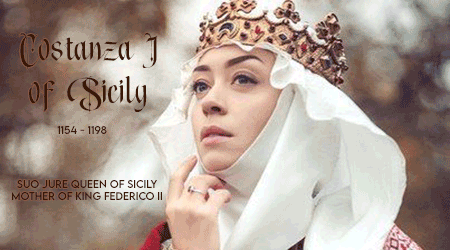#Margaret Constance Williams biography
Link
Real name (Margaret Constance Williams) nickname (Maisie Williams) height ,weight,boyfriend,affairs ,weight,and more physical stats
#Margaret Constance Williams#Margaret Constance Williams bio#Arya Stark bio#Margaret Constance Williams biography#(Arya Stark)#game of thrones
0 notes
Photo






“The Norman monarchs tended to choose their wives not from among the families of powerful Sicilians. Rather, they married women from prominent European courts.
Thus, their wives might be presumed to have brought a European influence to the cultural life of the kingdom. However—despite the fact that a number of the Norman queens ruled as regents for their underage sons; despite evidence that some of the queens had the capacity to influence Sicilian culture and even exerted a certain amount of effort to this end—this does not seem to have been the case.
The Norman queens (like their husbands) were often larger than life characters, whose extraordinary biographies reflect the turbulent times in which they lived. Roger II married a woman by the name of Elvira, daughter of a Spanish king (Alfonso VI, king of Castile and León) and his Moorish wife (Zaida, who took the Christian name Isabella when she married Alfonso). The marriage seems to have been a sentimental as well as a dynastic success. Elvira bore Roger five sons, including the next king of Sicily, William I, before she died in 1135, at the age of about thirty five. A medieval historian reports that following Elvira’s death, Roger was “so saddened by the bitterness of mourning that he closed himself for many days in his room, and did not appear except to his private staff; and so it happened that a rumor gradually spread, not only to those who were far away but even to those in the immediate proximity, that Roger had died.” Roger was obliged to put down an attempted coup when an ambitious Sicilian count sought to take advantage of the power vacuum resulting from the king’s withdrawal from the public eye.
Although Elvira had given Roger five sons, only one of them—the sickly, unpromising William—reached maturity. Fifteen years after Elvira’s death, Roger was obliged to marry again in order to ensure succession. Again, his long celibacy was quite extraordinary. Even with a plurality of potential heirs, a medieval king was likely to remarry following the death of a wife, both because marriage presented an opportunity to forge political alliances and because a consort came in handy at state ceremonies. Roger’s reluctance to remarry seems to provide further evidence of his affection for Elvira.
But William, against the odds, survived his father and was crowned king of Sicily following Roger’s death. In about the year 1150, he married Margaret of Navarre, daughter of King Garcia IV Ramirez of Navarre and Margaret de l’Aigle. The biography of William’s consort demonstrates what would become a truism of the Norman queens: they attracted attention, in general, only when their actions offended public opinion. Following her husband’s death, while Margaret ruled as regent for her son, the second William, she summoned a party of Frenchmen to Sicily (including Peter of Blois, who acted as tutor to young William). The Sicilians were not pleased at the influx of foreigners; nor did the French seem inclined to lengthen their stay in Sicily, although Margaret insisted and ultimately prevailed on this point. With Margaret’s support, one of the Frenchmen—Stephen, son of the count of Perche—was made chancellor and archbishop-elect of Palermo. This action earned her the enmity of the Sicilians, who resented the power given to a “puerum alienigenam” (a foreign-born boy) and suspected that less than professional sentiments motivated the queen’s actions. It was said that “the queen, although she was Spanish, called this French boy her brother, spoke to him too familiarly, and looked at him with hungry eyes; they feared that under the cover of professional proximity, an illicit love was hidden.” But Margaret’s efforts to staff her court with Europeans proved unfruitful. Peter of Blois soon left Sicily and described the island afterward as a hazard to travelers by virtue of both its climate and its people (“Sicily is to be faulted because of its air, and it is to be faulted for the malice of those who live there; I consider it hateful and almost uninhabitable”). Stephen’s (and Margaret’s) political enemies would drive Stephen himself out of Sicily in 1168.
So, too, a late Norman consort—Sibilla, wife of Tancredi of Lecce, an illegitimate grandson of Roger II who vied for control of Sicily following the death of William II in 1189—drew the enmity of her contemporaries by virtue of her political machinations. We possess a wholly unsympathetic account of Sibilla in the history written by Peter of Eboli. Peter, a partisan of Sibilla and Tancredi’s rivals for the Sicilian throne, Norman Constance and Hohenstaufen Henry VI, details an intrigue that pitted Sibilla against Constance. In the opening chapter of this unsavory history (which, in honesty, seems to consist of equal parts polemic and factual account), Tancredi asks Sibilla to invite Constance to Palermo. In her reply to him, Sibilla accuses him of raving senselessly; to honor Constance with her company, Sibilla believes, would implicitly acknowledge Constance’s authority. In the end, Constance, rather than being received as an honored guest, was imprisoned by Tancredi and Sibilla. But the ruse did not last long. The pope interceded and Constance was released to the keeping of her husband. Following Henry’s elevation to the Sicilian throne, Sibilla would repent and seek forgiveness for her scheming; she, along with her daughter, would end her life in an Alsatian convent.
The machinations of that Constance against whom Sibilla plotted, of course, would have a more appreciable effect on history. And historians would repay Constance in kind, making her (like the kings of Sicily) the protagonist of fantastic tales. Constance, daughter of Roger II, had been consigned to a convent, from which she was summoned to marry her Hohenstaufen husband in order to grant dynastic support to his Sicilian ambitions. She had already reached an advanced age, by medieval standards, when she was married and had passed her fortieth birthday when she bore her first and only child, Frederick II. The fourteenth-century historian Villani reports that Frederick’s birth challenged belief on two counts: because he was born to a woman consecrated to God, and because of his mother’s age (which he exaggerates, giving her more than fifty two years when she gave birth). The Sicilians, Villani says, frankly doubted Constance’s capacity to bear a child at her age; “for which reason, when the time came for her to give birth, she had a tent pitched in the center of Palermo, and made an announcement that any woman who wished might come to see her. And many came and saw, and so the suspicions ceased.” Giovanni Boccaccio, in his biographical dictionary of famous women, exaggerates both Constance’s age—he calls her a “wrinkled old woman”—and the prophetic significance of her pregnancy and Frederick’s birth. He attributes to Constance’s son the responsibility for the eventual fall of the Kingdom of Sicily. And after detailing his (rather fantastic) version of Constance’s late marriage and pregnancy, he asks: “Who will not judge Constance’s conception and childbirth to be monstrous?” In truth, Constance’s actions were characterized by less supernatural portent and more pragmatic significance. Following Frederick’s birth (in 1194, and in Iesi, not Palermo) and Henry’s death (in 1197), Constance ignored her husband’s wishes that a German ally be made Frederick’s regent. She sent the Germans out of Sicily, named the pope regent to her son, and had the four-year-old prince crowned king of Sicily in Palermo, before her own death in 1198.
History might remember the name of the Sicilian queen, particularly when she—like Margaret of Navarre or Constance, or like Adelaide, Roger II’s mother—acted as her son’s regent following her husband’s death. But the queens seem to have had little appreciable impact on the cultural life of the kingdom. The Norman kings tended to marry women from European (typically French or Spanish) courts, like the consorts mentioned above—with the exceptions of Sibilla, wife of the illegitimate and luckless Tancredi, and Constance, wife of the scion of a German house, both of whom were Sicilians. William II married Joanna Plantagenet, daughter of Eleanor of Aquitaine, a name that looms large in the history of European literature. But even this match seems to have done little to promote Romance letters in Sicily. Rather, the Norman monarchs seem to have pursued a diametrically opposed literary policy: they solicited the production of poetry in Arabic.”
Karla Mallette, The Kingdom of Sicily, 1100-1250. A Literary History, p. 93-97.
#history#history of women#women in history#historical women#women#adelasia del vasto#elvira of castile#margarita of navarre#joan of england#sibilla of acerra#costanza i#people of sicily#women of sicily#historyedit#myedit
138 notes
·
View notes
Link
This Biography is about one of the best Journalist Connie Chung including her Height, weight, Age & Other Detail…
Biography Of Connie Chung Real Name Connie Chung Profession Journalists Famous as Journalist Nationality American Personal life of Connie Chung Born on 20 August 1946 Birthday 20th August Age 70 Years Sun Sign Leo Born in Washington, D.C., United States Family Background of Connie Chung Father William Ling Chung Mother Margaret Ma Spouse/Partner Maury Povich Personal Fact of Connie Chung
Constance Yu-Hwa Chung Povich, popularly known as Connie Chung, is a well-known American journalist of Chinese origin. During her career, she has worked as an anchor as well as a reporter for the U.S. television news networks such as NBC, CBS, ABC, CNN and MSNBC. She launched a program Eye to Eye with Connie Chung which became quite popular across the country.
The program was mixed with news and celebrity-friendly feature interviews. Though the program was popular among viewers, Chung was criticized for focusing more on entertainment rather than news. In 1993, she became only the second woman to co-anchor CBS Evening News, along with being the first Asian American woman to become an anchor in a major network newscast of the United States of America. She has conducted several famous interviews as well, including that of the US Representative Gary Condit, who was interviewed after the Chandra Levy disappearance.
She also interviewed the famous basketball player Earvin Johnson after he announced publicly that he was HIV-positive. She gained controversy after the Oklahoma City bombing in 1995 because of an inappropriate question which she had posed to a fireman during an interview. Her question was considered highly insensitive to the situation and resulted in protest letters from the viewers. After much public outcry, she was laid off as a co-anchor of the CBS Evening.
This Biography Written By 7infi.com
0 notes